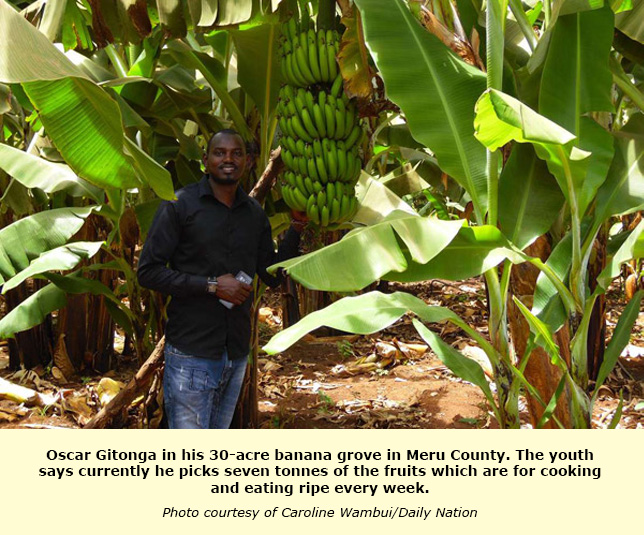A muddy road stretching for about 2km from Mitunguu Town in Meru County leads us to Verdant Farm in Rwompo village. The farm can be described as a banana haven and is run by Oscar Gitonga, 28.

Gitonga, a telecommunication engineer turned farmer, grows the bananas on 30 acres, producing them huge, tasty and in big numbers that he has kept his tens of customers, from as far as Nairobi, satisfied.
The second born in a family of three farms the Williams variety, which he says has an average height, doesn’t require much staking, the trunk is sizeable and strong and it needs less water and low maintenance.
“Initially, I used to grow the Giant Cavendish variety. Though it has good quality bananas, its trunk is thin and during the rainy season, in most cases the plant falls leading to losses. I also found that Cavendish needs lots of water, manure and fertiliser making it expensive,” says the farmer, who inherited the business from his father, and expanded it.
It is over five years since Gitonga started growing the crop and has perfected the art of farming bananas.
“To grow good bananas, you need 3ft by 2ft deep holes. Bananas should be planted deep for good anchorage. This also helps to prevent premature emergency of suckers. I put in the hole a wheelbarrow of manure and two handfuls of inorganic fertiliser, which I mix thoroughly with soil before planting,” Gitonga offers.
The spacing from one plant to another is 13ft by 12ft. A larger spacing is disadvantageous especially for places with water shortage as it does not allow the formation of a canopy.
“A large spacing also necessitates more staking to stop the bananas from falling. But with a spacing of 13ft by 12ft, staking is minimal, the canopy forms fast at eight months and water doesn’t dry fast on the ground,” offers Gitonga, who has some 6,000 banana plants.
HEALTHY, LIGHT-GREEN LOOK
At eight months, Gitonga applies three wheelbarrows of manure per plant, but this time spreads it around the crop.
He gets the animal manure in large quantities from Isiolo and Samburu, where residents are pastoralists.
He further applies three bags of fertiliser per acre at the onset of each rainy season.
“If during the April rains I used NPK 17:17:17, during the October rains I use NPK 23:23:0. My bananas normally flower at eight months and produce a lot of suckers due to good husbandry,” he says.
The plant starts to produce the fruit after about a year and Gitonga begins picking them six months later when they are ready. Currently, he says he picks seven tonnes of fruits which are for cooking and eating ripe every week.
“When bananas are still immature, they have sharp corners but when ready for harvesting, they take a round shape. Bananas also take a healthy light green appearance when ready,” he offers.
He normally picks, grades and packs the produce in crates, which ensures that the fruits aren’t bruised and their shelf-life is improved.
The farmer sells his bananas mainly to traders in Nairobi, earning at least Sh30,000 (USD297) per month from every acre.
“I harvest the bananas all-year-round by growing them in cycles where as some are being harvested, others are being planted while others are maturing,” he says, noting he gets suckers to plant from his farm.
So, how did Gitonga get into the lucrative banana farming?
BLESSING IN DISGUISE
The farmer studied telecommunications and information engineering at the Liaoning University of Technology in China, completing the course in 2013.
“When I returned home, I was determined to secure a well-paying job. The only job I got after a lengthy search was with a Chinese firm in Nairobi that offered me Sh55,000 (USD 545) a month,” he says.
Considering the pay too low, the farmer worked for a few months and returned to the village to take up banana farming from his father, who was a teacher at Materi Girls and retired.
“My parents welcomed my idea to farm bananas on the 12 acre family land, but I have now bought 18 more acres bringing to total 30,” says the farmer, who also grows pawpaws and watermelons, and isolates panama, nematodes and weevils as threats to his bananas.
Gitonga, who is now a happy farmer, terms his failure to get a job a blessing in disguise.
“If I have gotten that white-collar job, perhaps I would now be working on telecommunication masts but I am happy earning more from the soil. From the bananas I have also diversified into dairy farming rearing 15 Friesian cows, six of which are bulls, four are heifers, and I milk five getting 30 litres from each daily,” he says.
Benald Kinoti, an agricultural officer at the Ministry of Agriculture Meru County office, says banana farmers should be wary of yellow and black sigatoka diseases and panama.
“One should employ cultural methods and practice proper crop husbandry, have the right number of plants and have the right spacing and ensure that there is no wetness on the farm to curb the diseases.”
Written by Caroline Wambui, Daily Nation
